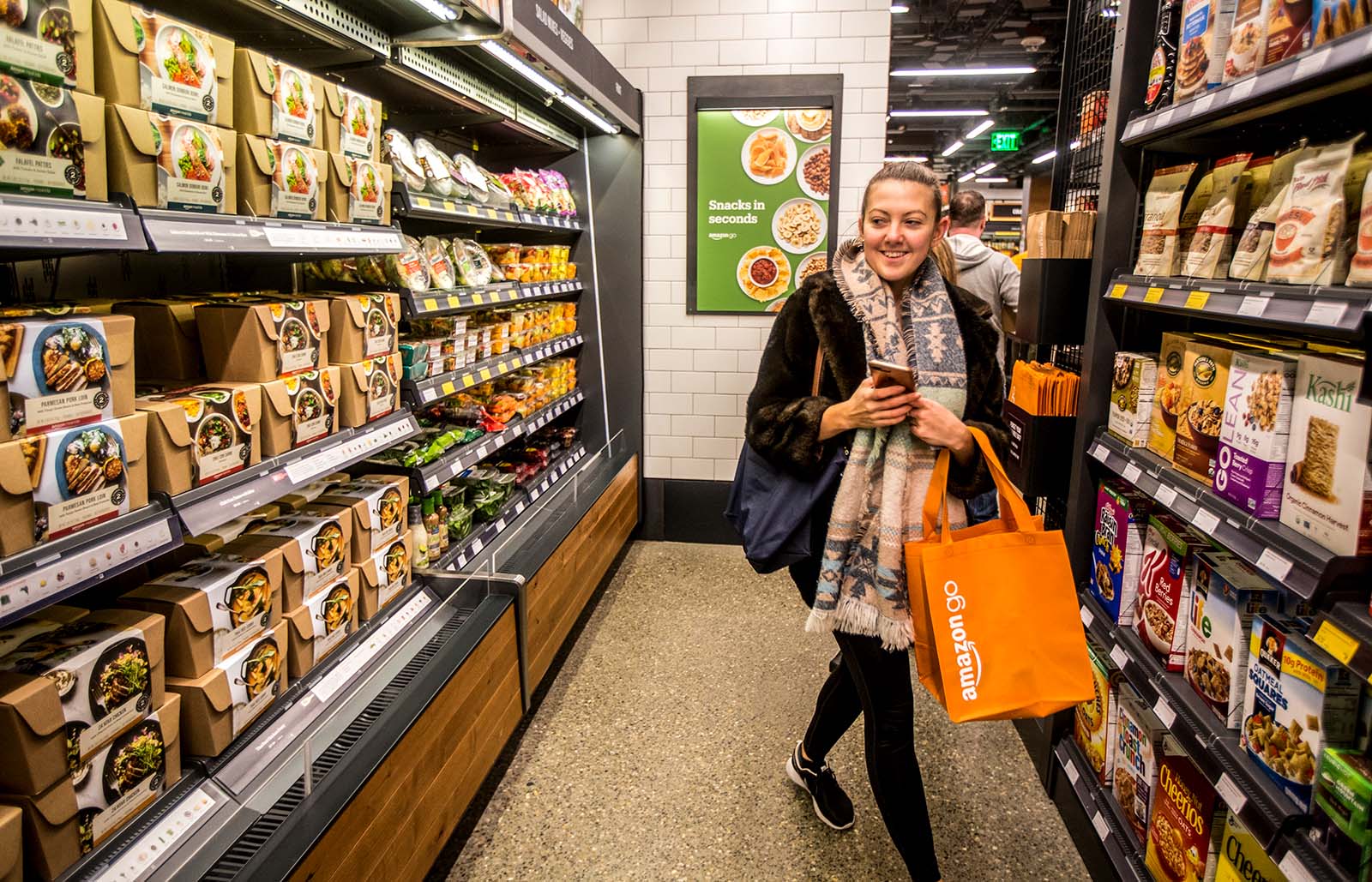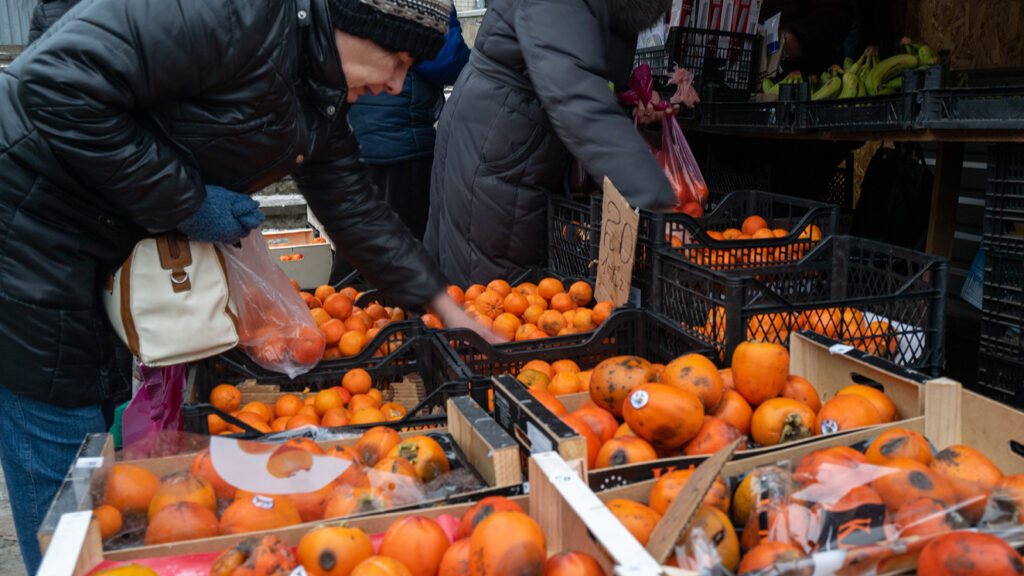Amazon Plots the Future of Food

Shopper Ela Ustel walks through the Amazon Go store in Seattle, Washington. After more than a year in beta, Amazon opened its first cashier-less store to the public in January 2018.
Photo: Stephen Brashear/Getty Images
Amazon’s acquisition of Whole Foods Market last year heralds a new era in the food sector. Up to now there’s always been a seeming incompatibility between the food business and Amazon’s traditional business model: People often buy small quantities of fresh products frequently, and they like to be able to see—and feel—the fresh products they are buying.
But this move will enable Amazon to raise its presence in the food space to a new level. Amazon has lacked a great range of food products; Whole Foods is a recognized, trusted brand with a fantastic assortment. Amazon did not have expertise in running a groceries business; the acquisition brings with it an understanding of on-the-ground food retailing. And by combining sales of food and other items, Amazon will gain scale that reduces the cost of delivery and enables price reductions across the grocery range.
Supermarket stocks fell in expectation that Amazon would take market share off incumbents and trigger price deflation throughout the market. We fully expect to see further consolidation as weak players go out of business or are acquired—perhaps first in the United States, but soon spreading to other countries. Further down the road, Amazon could change the way people shop for groceries, turning a business that delivers a good—food—into one that provides a service by fulfilling food needs through an array of customized suggestions and subscription services.
A Chance To Experiment
In the short term, Amazon looks to derive value from the acquisition and start experimenting with future ideas. Time and again, Amazon has been willing to invest heavily to dominate its chosen categories.
Whole Foods stores will function as click-and-collect points for buyers of Amazon’s other products. This will reduce costs and delivery times and attract potential customers who find home delivery inconvenient today. This extra customer traffic will lift the stores’ food sales, too.
Whole Foods’ local customer knowledge and connection to local suppliers are among the best in the industry. Combining them with Amazon’s efficient, centralized, technology-driven approach could be a tremendously powerful combination in both Amazon’s and Whole Foods’ traditional markets.
Amazon will likely ramp up its fresh food operations step by step, adding and testing new features and ways of combining online capabilities and physical stores. An early example is its move to make Amazon Prime the loyalty program for Whole Foods.
The Future of Food Retail
Piece by piece, Amazon will remove the barriers to online fresh food sales, notching up economic advantages that will enable it to offer unbeatable prices for food just as it does for other products. Many of the necessary elements would be difficult or take time to build without their acquisition. But in one go Amazon has acquired top-quality own-label products, a nationwide network of stores, and a temperature-controlled supply chain—not to mention Whole Foods’ large set of affluent customers.
Not all of Amazon’s moves are obviously related. They are like a magic picture that first appears to consist of formless dots until you stare at it for a while and the image becomes clear. That picture is the future of food retail, which has for the most part remained stubbornly offline for a number of reasons.
Moving Food Online
There’s traditionally been customer resistance to buying food online. Delivery is expensive. People worry that the fresh food won’t be what they want or that it might arrive in poor condition. Moreover, they don’t see that much to gain by shifting from supermarkets to online food shops. Amazon will gradually provide fixes for these problems.
Food retail is transforming into an information business, driven by the collection and analysis of data—and Amazon has a big advantage.
The first steps to unlocking online food are likely to be improvements in delivery. Delivery has been very hard for fresh food, which requires special conditions: Each foodstuff must be kept at the right temperature and it must arrive quickly, as customers often buy fresh food for cooking the same day.
People do not like waiting around for deliveries, so slots must be narrow, which can mean a van having to make multiple trips to a single area. As a result, delivery is expensive, leading to measures such as charges or minimum order sizes that run counter to many consumers’ desire for small quantities to eat right away.
How To Get Creative with Delivery
Amazon is already chipping away at the problem. Many AmazonFresh customers add one or two high-margin non-food items to their baskets, making food dispatches more cost-effective. This may not sound like much, but it can transform a loss-making order into one that breaks even or even turns a profit, giving Amazon a huge advantage over retailers without this capability.
Other creative options can be expected, too. Amazon could proactively suggest orders at times when a van is scheduled to be in the neighborhood and optimize slots in real time to coordinate different customer requests: “Would you mind if the order came 30 minutes earlier?”
Uber-type networks for delivery might emerge. All these possibilities will make fulfillment more efficient, reducing Amazon’s costs and the prices it needs to charge.
Digital Food Butler
The step change in online food will come from sophisticated, artificial intelligence-driven services that help customers plan and manage their food needs. Shoppers will select products the way they find easiest, using auto-populated lists, setting parameters for an app to make suggestions, or simply barking an order at Alexa, Amazon’s voice-interactive personal assistant.
Subscription services could monitor store cupboards and then suggest additional items to complete a new recipe. As Amazon gets to know individual customers’ preferences, dietary requirements, and seasonal habits, it will take over the management of household items and act as a digital food butler.
Food Is Data
Food retail will thus be transformed into an information business, driven by the collection, analysis, and use of data. Not only will Amazon benefit from its digital lead in overall retail, it will also get a first-mover advantage in machine learning for food sales. Algorithms improve as they absorb more data, and Amazon will gather more information than other retailers, because it will be ahead of the game in more markets.
The data will be incredibly valuable, as it will probably be the best—and perhaps only—global treasure trove of information on food purchasing habits. Food manufacturers—that is, Amazon’s suppliers—will be prepared to pay a lot for this information and related analysis, improving Amazon’s economic model further.
Amazon could soon have an unassailable competitive advantage.






